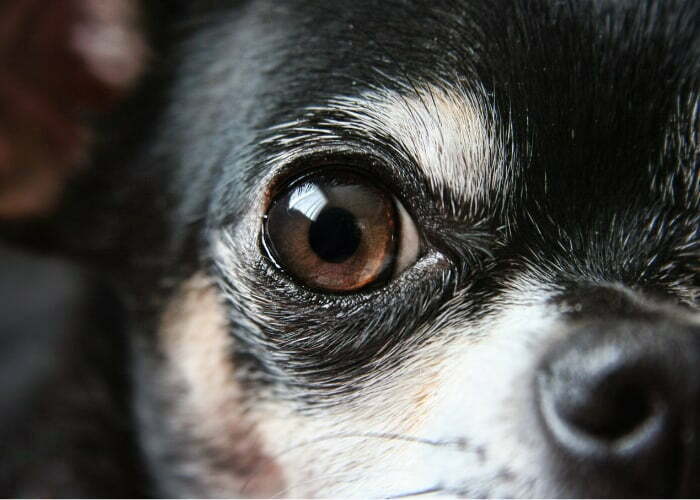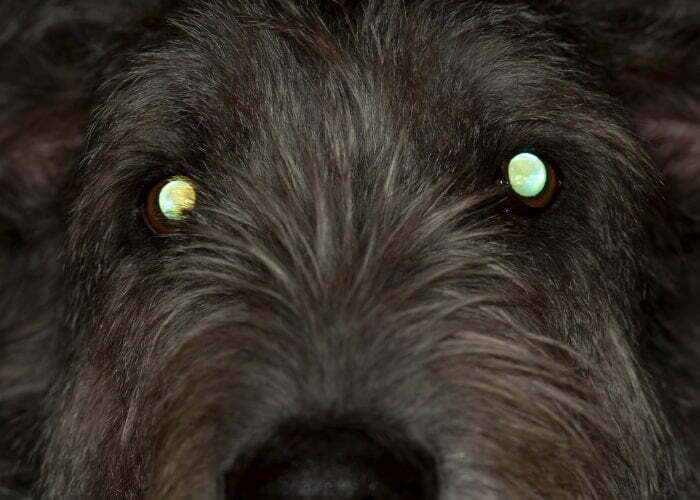Although cats bask in the pride of being the overall pet champ of night vision, dogs can also navigate through the darkness with ease. So, can dogs see in the dark? Yes, their vision in darkness is not as good as the cats but better than humans. Dog’s eyesight in darkness is attributed to their eye structure.
Dogs have large pupils that allow in more light. Their retinas have many light-and-motion-sensitive cells that help differentiate between light and shadows.
Dog’s eyes have mirror-like membranes situated at the rear end of each eye. These membranes are called tapetum lucidum whose function is to rebound unabsorbed light to the retinas. This allows for more intakes of light and thus a clearer vision.
Can Dogs See In The Dark?
Yes, dogs can see in the dark. While they can see better than humans in the dark they cannot see perfectly when it is pitch black.
Long ago, dogs used their eyesight at night to continue to hunt. Nowadays, dogs do not need to worry about that, but if they were outside at night to use the bathroom, they will be able to see things you can’t.
The Canine Eye
The canine eye is a general term used to refer to eyes that belong to animals such as cats and dogs. The canine eye has light-sensitive rods that aid vision even in little light.
Compared to humans, dogs have more rods, which partly explains their better sight in the darkness. Their eye’s retina has cones that determine and differentiate the colors that dogs see.
Flicker Fusion Frequency influences a dog’s ability to have better vision in little or no light. Speed enhances the Flicker Fusion Frequency. That is, the faster the animal, the higher the FFF. A dog’s ability to see in darkness can also be attributed to a part of the canine eye known as tapetum lucidum. Its work is to mirror unabsorbed light to the retina.
Do Dogs Have Night Vision?
No, dogs do not have night vision in the way we think where you are wearing night vision goggles and can see everything in the pitch black vividly. Eyes need a light source to project the image in the dark so no dogs do not have night vision and they cannot see everything in the dark.
If your dog is going to be in a dark room, you can eliminate anything your dog might run into not being able to see it. Make sure the floor area is tidy enough that your dog won’t get hurt.
Dog Night Vision
A dog’s vision in complete darkness is the same as a human’s, but with the presence of little light, their eyes can utilize the little amount of light available.
Their eyes are structured in such a way that they efficiently use the little light, and any that passes through unabsorbed it is reflected back to the retina.
Dog’s night vision may be blurred, but they can still recognize movements. In low light, a dog can detect motion thanks to the wider retinas and more rods.
Dog’s eyes are no better than ours, just that they are more efficient by utilizing even the smallest amount of light. Many may wonder how their dogs can navigate their homes in the dead of the night, but this could be attributed to the familiarity of the place.
If you are not fond of rearranging your house now and then, your dog can maintain the layout of the house at the back of his head.
Dog’s Motion Sensitivity
Dog’s eyesight is worse than humans regarding color, but when motion sensitivity is compared, dogs beat humans hands down. Dogs can detect small movements faster than humans can.
Motion sensitivity is an essential aspect of the canine eye. Better motion sensitivity is due to increased number of rods. This enables dogs to detect movement, which the human may find difficult to notice.
Why Do Dogs Eyes Glow?
Ever noticed that your dog’s eyes glow when light shines on him in the dark? It’s awesome, especially for dogs that have a greenish-yellow glow. The tapetum lucidum causes this glow. The tapetum reflects any unabsorbed light to the retina. Thus, enabling the photoreceptors to absorb the unabsorbed.
The tapetum, through a process called fluorescence, amplifies the light. This causes a color shift and increases in the light’s brightness. This color shift increases the wavelength to a point where the rods can best and easily detect the light.
The tapetum can reflect 130 times more than our human eyes. This makes the canine eye more sensitive than the human eye.
The most efficient field of view further enhances Their increased vision in low light. The standard field of view for dogs is 250 degrees, while that of humans stands at a mere 190 degrees.
Dog’s eyes are structured in such a way that they can utilize light that is five times dimmer than the human eye.
Your dog has a better binocular vision than animals like horses, which is attributed to the fact that the eyes are situated at the front rather than the sides. This allows a dog to use both his eyes to focus on an object.
The object distance determines the clarity of the image since the dog is not able to focus as well as humans do. A dog’s vision is roughly 20/75. This means that what a dog can clearly see from 20ft a person can view the same from 75ft.
Dog’s Focus In Low Light
Due to many rods, wider retinas, and the tapestry of light, dogs can efficiently utilize light. Dogs have little clarity compared to humans because of having fewer cones.
Cones are cells that are responsible for things like detail and color. Since dogs have the tapetum lucidum and wider cones, they are deprived of the luxury of having many cones.
This greatly reduces their clarity when trying to focus on an object. The lack of clarity results in a blurry image with little distinct features. All these elements are different depending on a dog. Some may have slightly better or slightly worse vision.
Why Do Dogs Bark at Night?
When your dog barks at night, it can be caused by a lot of different reasons. One reason may be because your dog is afraid of an object in the dark room. When it is pitch black dark objects can take on a different look or shadow that can become frightening to your dog.
Another reason could be that your dog has seen a pest running around, such as a mouse. Since dogs can see much better than us, it is possible for your dog to detect a moving mouse around a dark room. Lastly, your dog could just be barking at night because it can hear other dogs barking.
Conclusion
Dogs appear to have better vision in darkness than human beings, which is because they can use the little light available. They can easily detect motion but have lower clarity as compared to humans.
Dogs are able to walk around in darkness partly due to the familiarity of the areas and part due to having the tapestry of light. However, this doesn’t mean that you leave your dog in darkness. Be kind and provide your canine buddy some light.
Now you know the answer to can dogs see in the dark. Does your dog do strange things in the dark? Let us know.


